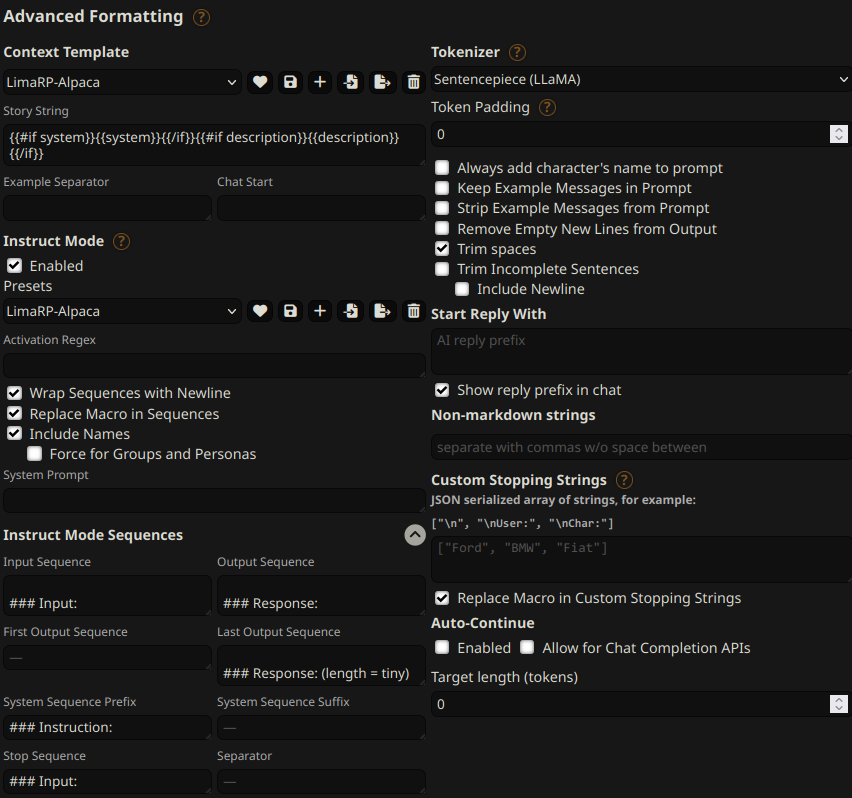File size: 5,020 Bytes
20418bf 4c6fa67 4d76b14 28322a9 4c6fa67 74e9cd7 4c6fa67 74e9cd7 4c6fa67 78c69b1 4c6fa67 ac34889 4c6fa67 28322a9 4c6fa67 28322a9 4c6fa67 ed5aae9 502e506 4c6fa67 554bde2 a5dec36 554bde2 a2ffb30 a5dec36 554bde2 4c6fa67 b88be3a 4c6fa67 b88be3a 4c6fa67 28322a9 4c6fa67 28322a9 4c6fa67 4d76b14 4c6fa67 4d76b14 28322a9 4c6fa67 4d76b14 b88be3a |
1 2 3 4 5 6 7 8 9 10 11 12 13 14 15 16 17 18 19 20 21 22 23 24 25 26 27 28 29 30 31 32 33 34 35 36 37 38 39 40 41 42 43 44 45 46 47 48 49 50 51 52 53 54 55 56 57 58 59 60 61 62 63 64 65 66 67 68 69 70 71 72 73 74 75 76 77 78 79 80 81 82 83 84 85 86 87 88 89 90 91 92 93 94 95 96 97 98 99 100 101 102 103 104 105 106 107 108 109 110 111 112 113 114 115 116 117 118 119 120 121 122 123 124 125 126 127 128 129 130 131 132 133 134 135 136 |
---
license: apache-2.0
---
# LimaRP-Mistral-7B-v0.1 (Alpaca, 8-bit LoRA adapter)
This is a version of LimaRP for [Mistral-7B-v0.1](https://huggingface.co/mistralai/Mistral-7B-v0.1) with
about 1900 training samples _up to_ 9k tokens length
For more details about LimaRP, see the model page for the [previously released v2 version for Llama-2](https://huggingface.co/lemonilia/limarp-llama2-v2).
Most details written there apply for this version as well. Generally speaking, LimaRP is a longform-oriented, novel-style
roleplaying chat model intended to replicate the experience of 1-on-1 roleplay on Internet forums. Short-form,
IRC/Discord-style RP (aka "Markdown format") is not supported yet. The model does not include instruction tuning,
only manually picked and slightly edited RP conversations with persona and scenario data.
## Known issues
- Despite performing a few finetuning attempts, including one that followed almost the same procedure as in previous releases,
Mistral-7B-v0.1 appears to have strange repetition issues.
- Even though benchmarks tell a different story, in practice the model doesn't feel smarter during roleplay than Llama-2-13B.
## Prompt format
Same as before. It uses the [extended Alpaca format](https://github.com/tatsu-lab/stanford_alpaca),
with `### Input:` immediately preceding user inputs and `### Response:` immediately preceding
model outputs. While Alpaca wasn't originally intended for multi-turn responses, in practice this
is not a problem; the format follows a pattern already used by other models.
```
### Instruction:
Character's Persona: {bot character description}
User's Persona: {user character description}
Scenario: {what happens in the story}
Play the role of Character. You must engage in a roleplaying chat with User below this line. Do not write dialogues and narration for User.
### Input:
User: {utterance}
### Response:
Character: {utterance}
### Input
User: {utterance}
### Response:
Character: {utterance}
(etc.)
```
You should:
- Replace all text in curly braces (curly braces included) with your own text.
- Replace `User` and `Character` with appropriate names.
### Message length control
Inspired by the previously named "Roleplay" preset in SillyTavern, with this
version of LimaRP it is possible to append a length modifier to the response instruction
sequence, like this:
```
### Input
User: {utterance}
### Response: (length = medium)
Character: {utterance}
```
This has an immediately noticeable effect on bot responses. The lengths using during training are:
`micro`, `tiny`, `short`, `medium`, `long`, `massive`, `huge`, `enormous`, `humongous`, `unlimited`.
**The recommended starting length is medium**. Keep in mind that the AI can ramble or impersonate
the user with very long messages.
The length control effect is reproducible, but the messages will not necessarily follow
lengths very precisely, rather follow certain ranges on average, as seen in this table
with data from tests made with one reply at the beginning of the conversation:

Response length control appears to work well also deep into the conversation. **By omitting
the modifier, the model will choose the most appropriate response length** (although it might
not necessarily be what the user desires).
## Suggested settings
You can follow these instruction format settings in SillyTavern. Replace `tiny` with
your desired response length:

## Text generation settings
Mistral-7B-v0.1 appears to have repetition issues. A low temperature combined with a relatively high
repetition penalty and low penalty range (about as long as the prior 2 messages) appears to help:
- TFS = 0.90~0.95
- Temperature = 0.50~0.55
- Repetition penalty = ~1.15
- Repetition penalty range = ~512
- top-k = 0 (disabled)
- top-p = 1 (disabled)
## Training procedure
[Axolotl](https://github.com/OpenAccess-AI-Collective/axolotl) was used for training
on 2x NVidia A40 GPUs.
The A40 GPUs have been graciously provided by [Arc Compute](https://www.arccompute.io/).
The model has been trained as an 8-bit LoRA adapter, and
it's so large because a LoRA rank of 256 was also used. The reasoning was that this
might have helped the model internalize any newly acquired information, making the
training process closer to a full finetune. It's suggested to merge the adapter to
the base Mistral-7B-v0.1 model.
### Training hyperparameters
- learning_rate: 0.0005
- lr_scheduler_type: cosine
- num_epochs: 2
- sequence_len: 9000
- lora_r: 256
- lora_alpha: 16
- lora_dropout: 0.05
- lora_target_linear: True
- bf16: True
- fp16: false
- tf32: True
- load_in_8bit: True
- adapter: lora
- micro_batch_size: 2
- gradient_accumulation_steps: 32
- warmup_steps: 2
- optimizer: adamw_torch
For the second pass, the `lora_model_dir` option was used to continue finetuning on the LoRA
adapter obtained from the first pass.
Using 2 GPUs, the effective global batch size would have been 128. |